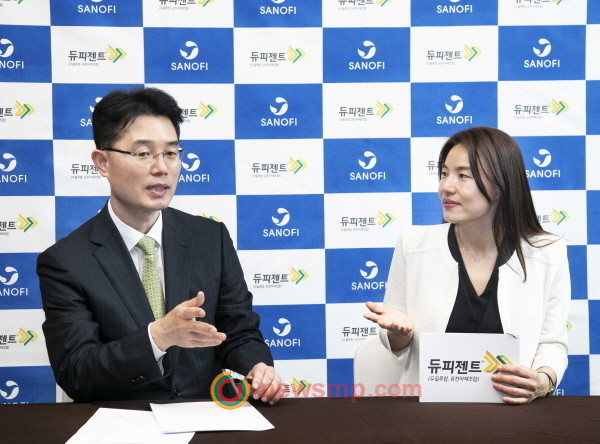Effective for eosinophilic asthma as well as type 2 inflammation in asthma… also reduces the amount of steroid used
‘Hope’ for steroid-dependent patients who did not benefit from powerful treatments
Dupixent (dupilumab, Sanofi), which gave new life to patients with severe atopic dermatitis, is also providing hope to patients with severe asthma.
It presents a new opportunity for severe asthma patients who had to rely on steroids despite side effects that were difficult to treat with conventional treatments.
In April, the Ministry of Food and Drug Safety (administrator Uigyeong Lee) approved Dupixent as additional maintenance for severe eosinophilic asthma, which is not properly controlled by existing treatments in adults and adolescents (ages 12 or older).

Then in May, the scope of the permission was extended to additional maintenance therapy of type 2 inflammation in asthma, which is corresponding to eosinophilic asthma (more than 150/㎕ of serum eosinophil) or exhaled nitric oxide (FeNo 25ppb or higher) and severe asthma of oral steroid-dependent, which are not controlled adequately by existing therapy.
Dupixent inhibits the signaling of interleukin (IL) 4 and 13 among various cytokines that cause asthma.
Unlike the biologicals that were first approved for severe asthma, Sanofi explains that two cytokines can be controlled and expected to work on both asthma symptoms caused by each cytokine.
Dupixent reduced the deterioration rate of severe asthma, improved lung function, and decreased steroid use in the LIBERTY ASTHMA clinical program, which involved a total of 2,888 adolescents and adult moderate-severe asthma patients.
In this study, the worsening annual rate of severe asthma for Dupixent 300mg decreased by 46% or higher (Dupixent administration=0.97, placebo group=0.52, p<0.0001). and 46% or higher in 200mg administration (Dupixent administration=0.87, placebo group=0.46, p<0.0001) at the 52nd week.
Pulmonary function was also shown to improve continuously after two weeks of administration of Dupixent, and 200ml of lung capacity enhanced compared to the placebo group at 52nd week in the 200mg administration group.
Moreover, more than half of patients with oral corticosteroid-dependent asthma stopped using oral corticosteroids entirely at 24 weeks of administration, and overall use was reduced by 70%.
Particularly, in the VENTURE study, 86% of patients decreased or suspended steroid use while maintaining asthma control in the oral steroid-dependent patients group. (p<0.0001)

In this regard, at the online press conference held by Sanofi on the 3rd to commemorate the expansion of Dupixent’s asthma indication, Professor Kim of respiratory allergic at Hanyang University Hospital said, “I was worried that there were not enough treatments for severe asthma, but I am glad to use new therapy.”
For that reason, he said, “Severe asthma is a symptom that various asthma treatments do not improve and show frequent exacerbation, and even systemic steroids are used without being controlled by continuous administration of various drugs, including bronchodilator,” and “We know that it is harmful, but we are forced to prescribe and take them.” He explained why new treatments are needed.
He points out that long-term use of steroids increases the risk of osteoporotic fractures and cardiovascular diseases, as well as chronic diseases such as diabetes and eventually raises the risk of hospitalization, emergency room visits, and even death due to these complications.
“Nevertheless, steroids are prescribed in the sense of guilt that there is no proper drug to control asthma, which can make patients worse,” Professor Kim said, “This is why we needed a proper therapy to replace steroids.”
In particular, he stressed, regarding Dupixent’s authorization to type 2 inflammation in asthma, “In the past, asthma was simply considered to be a contraction of bronchus, and we approached to expand it,” and “(type 2 inflammation in asthma) is an example of ‘personalized treatment’ that determines the phenotype of each patient’s asthma and selects the appropriate drug.”
In fact, the Global Initiative for Asthma (GINA)’s recent guidelines on asthma also recommend Dupixent as a treatment for type 2 inflammation in asthma that is not controlled by high-dose of ICS/LABA treatments.
Type 2 inflammation in asthma can be defined when one of the following is satisfied. ▲ measured during high doses of inhalation steroids (or oral steroids with minimum concentrations) treatment ▲ serum eosinophils 150 cells/μL or more, or sputum eosinophils 2% or more ▲ clinically induced asthma by allergic antigens ▲ exhaled nitric oxide (FeNO) 20 ppb or more ▲ oral steroids are required as a maintenance treatment
The type 2 inflammatory mechanism affects a wide range of diseases, including asthma, atopic dermatitis, and chronic sinusitis, and IL-4 and IL-13, which are worked by Dupixent, are known to be the central cytokines mediating this type 2 inflammation.
Therefore, Dupixent is expected not only in atopic dermatitis and asthma but also in other diseases related to type 2 inflammation.
However, he said, “Dupixent is a drug that inhibits the eosinophil, but in some patients, the eosinophil has increased rather,” and added, “There weren’t many patients who stopped taking the drug, but an increase in eosinophils can cause inflammation in many organs, so it’s one of the things you should watch with caution when using the drug.”
Sanofi also mentioned that the increase in eosinophil levels in Dupixent is not a clinically significant part. The FDA also is making the same judgment.
“Dupixent does not work directly on IL-5 but works at the top,” the Sanofi administrator said. “Therefore, since it controls asthma by directly suppressing the inflammation of the lungs, the level of the eosinophil may show a relative increase in the blood.”

He also added, “Due to the decrease in oral steroid doses after taking Dupixent, the eosinophil levels may increase relatively.”
“Patients, who had elevated their eosinophil levels, returned to the base level during the final phase and it did not lead to clinically meaningful adverse effects,” He included, “FDA also considers that the increase in eosinophil level has not had a clinical impact.”
Regarding the failure of pre-Dupixent biological medicines in the market, “There may be many reasons, but many people gave up treatment after taking one or two doses in the early stages before it worked because of the burden of drug costs.” He stressed, “In order to be effective, environmental changes are needed to enable active use of drugs.”


